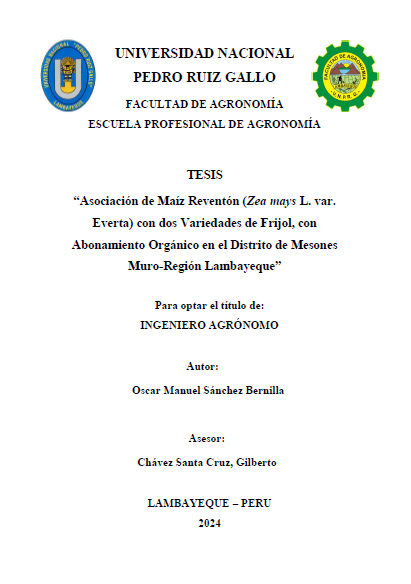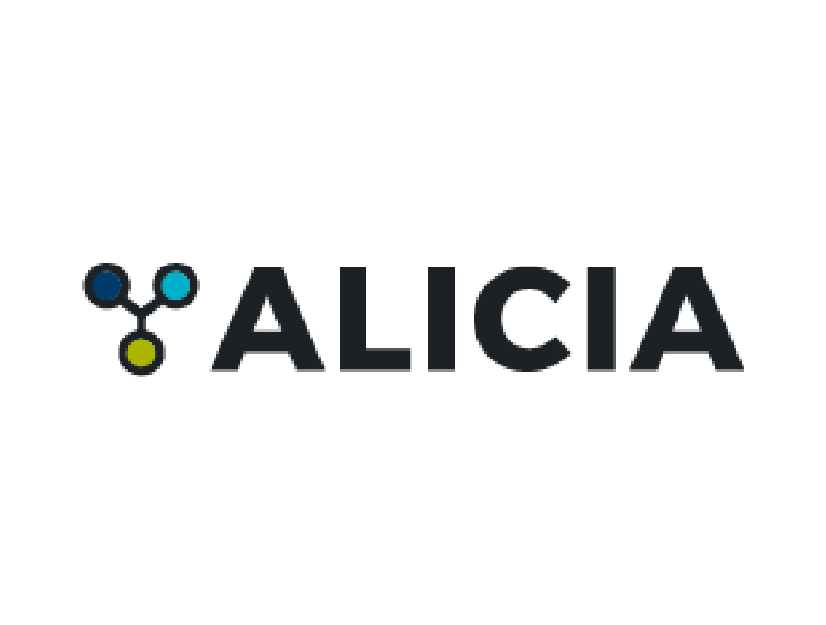Asociación de Maíz Reventón (Zea mays L. var. Everta) con dos Variedades de Frijol, con Abonamiento Orgánico en el Distrito de Mesones Muro-Región Lambayeque

Fecha
2019-12-20Autor
Sánchez Bernilla, Oscar Manuel
Metadatos
Mostrar el registro completo del ítemResumen
El trabajo de investigación se ejecutó en el distrito de Mesones Muro, provincia
de Ferreñafe, región Lambayeque, de junio a diciembre del 2018, en el predio del señor
Manuel Símpalo, ubicado a cuatro kilómetros de la ciudad de Ferreñafe, cuyo objetivo
de determinar la mejor asociación guano de islas - maíz - frijol, para incrementar los
rendimientos de maíz y frijol. Las labores empleadas del cultivo se realizaron
habitualmente para maíz y leguminosas en zonas costeras, se valoraron 12 tratamientos
con 4 repeticiones, aplicándose el diseño de parcelas divididas. Se evaluó altura de
planta y rendimiento, en maíz se calculó tanto altura de planta, así como también
rendimiento de grano, tamaño de mazorca, longitud, ancho de hoja y área foliar. La
hipótesis alternativa planteada al inicio de la investigación fue aceptada, por tanto, el
uso de Guano de islas incidió de forma positiva en las características evaluadas. Se
encontró el mayor rendimiento en la asociación Guano de islas (1 T/ha) - maíz Pop corn
- frijol Caupí con un rendimiento de 1.58 T/ha. Mientras que los rendimientos con los
valores más bajos se lograron en el tratamiento sin el empleo de Guano de islas - maíz
Pop corn - frijol Panamito, con solo 1.25 T/ha. Los impactos por el empleo de las
asociaciones Maíz - leguminosas fueron de tipo social, económico, tecnológico y
ambiental, por la mejor rentabilidad, por el uso de fuentes más completa de nutrientes y
la disminución de fertilizantes químicos, que mejoran la vida microbiológica del suelo,
respectivamente, además de tener un efecto residual en el tiempo. La asociación más
rentable fue Guano de islas - maíz Pop corn - frijol Panamito, con un beneficio de 12
080.00 soles y dejando 3.85 soles como índice de rentabilidad. The research work was carried out in the district of Mesones Muro, province of
Ferreñafe, Lambayeque region, from June to December 2018, in the farm of Mr.
Manuel Símpalo, located four kilometers from the city of Ferreñafe, with the objective
of determining the best association of island guano - corn - bean, to increase corn and
bean yields. The crop was usually grown for corn and legumes in coastal areas, 12
treatments were evaluated with 4 replications, applying the split plot design. Plant
height and yield were evaluated; in corn, both plant height and grain yield, ear size,
length, leaf width and leaf area were calculated. The alternative hypothesis proposed at
the beginning of the research was accepted, therefore, the use of Guano de islas had a
positive effect on the characteristics evaluated. The highest yield was found in the
association Guano de islas (1 T/ha) - Pop corn - cowpea with a yield of 1.58 T/ha. The
lowest yields were achieved in the treatment without the use of Guano de islas - Pop
corn - Panamito bean, with only 1.25 T/ha. The impacts of the use of maize-legume
associations were social, economic, technological and environmental, due to better
profitability, the use of more complete sources of nutrients and the reduction of
chemical fertilizers, which improve the microbiological life of the soil, respectively, in
addition to having a residual effect over time. The most profitable association was
Guano de islas - Pop corn - Panamito beans, with a profit of 12,080.00 soles and leaving
3.85 soles as profitability index.
Colecciones
- Agronomía [265]







